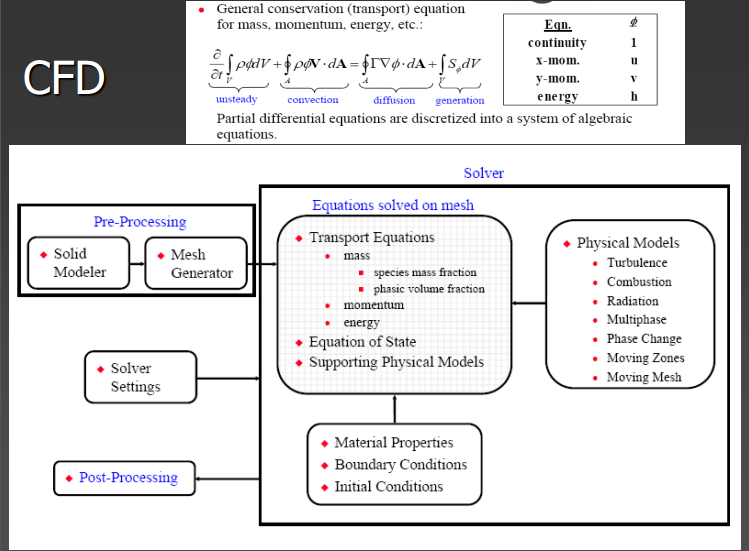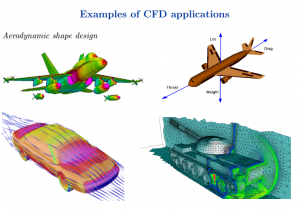
Table of Contents
Beginning The Journey of Computational Fluid Dynamics (CFD) Analysis
Computational fluid dynamics, known as a CFD analysis, is a branch of fluid mechanics that uses numerical methods and algorithms to solve and analyze problems that involve fluid flows.
Computers are used to perform the calculations required to simulate the interaction of liquids and gases with surfaces defined by boundary conditions. With high-speed supercomputers, better solutions can be achieved.
CFD is more used in aerospace industries for flow field simulation. There are some procedural steps followed by the CFD software for solving the solution of the model. These are:-
KNOW THE DIFFERENCE: BETWEEN WIND TUNNEL AND CFD
Problem Identification and Pre-Processing:
The geometry (physical bounds) of the problem is defined.The volume occupied by the fluid is divided into discrete cells (the mesh). The mesh may be uniform or non-uniform.
Solver Execution:
The physical modeling is defined – for example, the equations of motion +enthalpy + radiation + species conservation. Boundary conditions are defined.
This involves specifying the fluid behavior and properties at the boundaries of the problem. For transient problems, the initial conditions are also defined.
The simulation is started and the equations are solved iteratively as a steady-state or transient.
Post Processing and Analysis:
• Finally, a post processor is used for the analysis and visualization of the resulting solution. CFD use discretization methods for solving the simulation of the model in supercomputers.
Types of discretization methods used are finite element method, finite volume method, finite difference method, spectral element method, boundary element method. We will explain these types of discretization methods in short. The figure below shows the diagram of CFD preprocessing to post processing steps followed by software

Related: Best Aeronautical Engineering Notes For PTU &PEC Students
- FINITE ELEMENT METHOD: The finite element method (FEM) is used in structural analysis of solids, but is also applicable to fluids. However, the FEM formulation requires special care to ensure a conservative solution. The FEM formulation has been adapted for use with fluid dynamics governing equations. Although FEM must be carefully formulated to be conservative, it is much more stable than the finite volume method.
- FINITE VOLUME METHOD: The finite volume method (FVM) is a common approach used in CFD codes, as it has an advantage in memory usage and solution speed, especially for large problems, high Reynolds number turbulent flows, and source term dominated flows In the finite volume method, the governing partial differential equations (typically the Navier-Stokes equations, the mass, and energy conservation equations, and the turbulence equations) are recast in a conservative form, and then solved over discrete control volumes. This discretization guarantees the conservation of fluxes through a particular control volume.
- FINITE DIFFERENCE METHOD: The finite difference method (FDM) has historical importance and is simple to program. It is currently only used in few specialized codes, which handle complex geometry with high accuracy and efficiency by using embedded boundaries or overlapping grids, where is the vector of conserved variables, and, and are the fluxes in the, and directions respectively.
- SPECTRAL ELEMENT METHOD: Spectral element method is a finite element type method. It requires the mathematical problem (the partial differential equation) to be cast in a weak formulation. This is typically done by multiplying the differential equation by an arbitrary test function and integrating over the whole domain. Purely mathematically, the test functions are completely arbitrary – they belong to an infinite dimensional function space. Clearly, an infinitely dimensional function space cannot be represented on a discrete spectral element mesh. And this is where the spectral element discretization begins. The most crucial thing is the choice of interpolating and testing functions. In a standard, low order FEM in 2D, for quadrilateral elements the most typical choice is the bilinear test or interpolating function of the form. In a spectral element method, however, the interpolating and test functions are chosen to be polynomials of a very high order (typically e.g. of the 10th order in CFD applications).
5. Boundary Element Method:
In the boundary element method, the boundary occupied by the fluid is divided into a surface mesh
CFD ANALYSIS APPLICATIONS:
CFD is most valuable and crucial software in all developing industries for flow simulation.CFD used by:-
- Architects to design safe and comfortable living environment.
- Designers of the vehicle for improving the aerodynamic characteristics.
- Chemical engineer to maximize the yield from their equipment.
- Petroleum engineers to devise optimal oil recovery strategy.
- Surgeons to cure arterial diseases(computational hemodynamic)
- Meteorologist to forecast the weather and warn of natural disasters.
- Health experts to reduce the health risk from radiations and other hazards.
- Military organization to develop weapons and estimate the damage.

Computational Fluid Dynamics Books
Best and Reputed Books For Computational Fluid Dynamics are:
- Computational fluid dynamics by John D Anderson
- Computational fluid dynamics by Jiyuan Tu
- An Intro to computational fluid dynamics from Pearson publications
Discussions Forums on CFD Analysis
Some reliable and trusted forum on CFD are:


Most valuable post sir.It Include all basic information, info-graphics and Interest